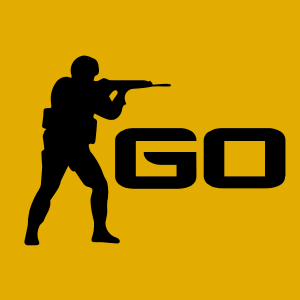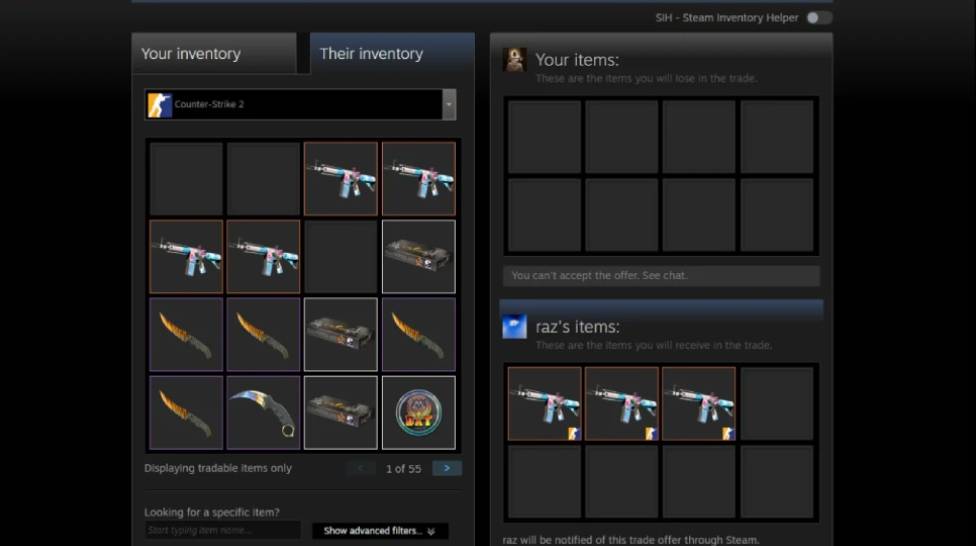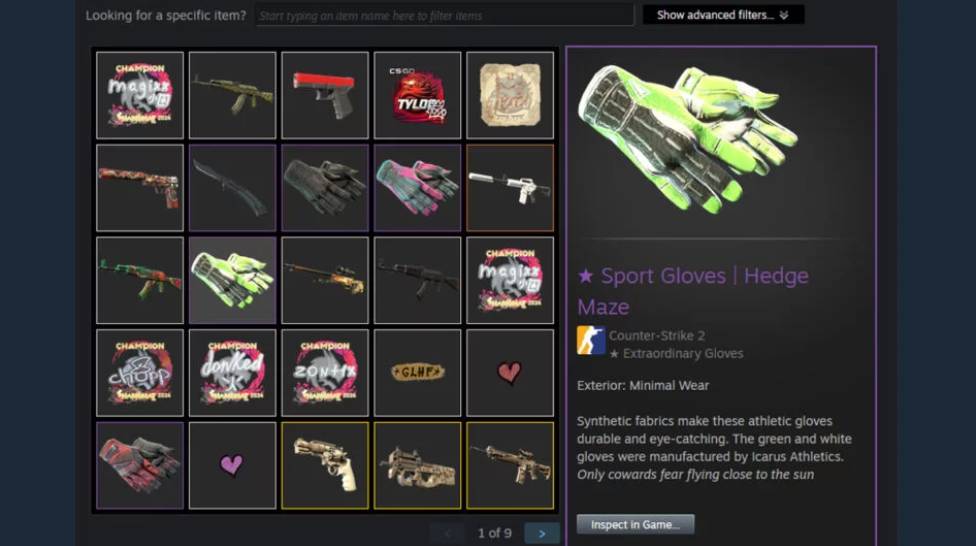Quick Takeaways
| Topic | Key Facts |
| Trading type | Peer-to-peer, within Steam only |
| Fees | No direct fee, but items can’t be converted to real cash |
| Main tools | Trade Offers, Steam Guard Mobile Authenticator |
| Holds | Typically 7–15 days if not secured by mobile |
| Safety | Never trade outside Steam, always check profile verification |
Trading vs. Market Selling
At first glance, both “trading” and “selling” seem identical. You move an item and get something back. But how it happens, and what you receive, changes everything.
Selling on the Market
- You list an item publicly.
- Another player buys it with wallet funds.
- Steam takes a 15% cut.
- The transaction is final and anonymous.
Selling is great when:
- You want guaranteed liquidity.
- You’re fine earning Steam Wallet credit.
- You don’t care who buys it.
Trading with Other Users
- You propose a swap directly (skin for skin, or skin for keys).
- No fee, but no Steam Wallet funds change hands.
- Each trade must be confirmed manually for security.
Trading is ideal when:
- You want a specific item, not just wallet value.
- You’re exchanging equal or close value items.
- You’re comfortable verifying people.
Think of it like bartering in a closed town. Everything stays inside, but the exchange rate depends on trust, timing, and taste.
Why Some Players Prefer Trading
Even with its quirks, trading remains a favorite among CS2 players because it’s more personal, flexible, and strategic.
- No 15% fee: Every trade is fee-free. If you’re trading a $100 knife, that’s $15 saved.
- Negotiation: You can discuss value, something the Market doesn’t allow.
- Bundle trades: Trade multiple items for one high-tier skin.
- Speed: Direct trades can settle instantly, with no waiting time for a buyer.
Of course, there’s the dark side: you can’t trade wallet funds, and scammers prey on inattention.
Trade Holds and Confirmations
Steam takes account security seriously, almost to the point of frustrating some players.
Every trade involves one or more security layers to prevent stolen items or hijacked accounts from being emptied overnight.
What is a Trade Hold?
A “trade hold” is a delay Valve places on item transfers when certain conditions aren’t met. Typical hold time range 7–15 days, depending on your security setup.
Holds apply when:
- Steam Guard Mobile Authenticator not active for ≥7 days.
- Login from a new device or IP.
- Account password recently changed.
Example: If you log in from a new PC and send a trade, the other user won’t receive your item for up to 15 days. The items are locked in escrow until both sides are verified.
Steam Guard Mobile Authenticator
This is the single best way to shorten or skip holds entirely.
Follow these steps to activate:
- Install the Steam Mobile App.
- Enable Steam Guard in settings.
- Wait 7 days (grace period).
- After that, trades are confirmed instantly.
Confirmations
Each trade appears in your mobile app. You must approve or decline before it finalizes. This prevents bot hijacks or “phantom” trades.
Never confirm trades outside the Steam Mobile app. Any web or chat link that looks “official” but asks for confirmation is a phishing attempt.
Trade Holds, Cooldowns, and Locks: The Hidden Mechanism
Not every account is trade-ready. Steam enforces several automated cooldowns based on account activity and security signals. It’s Valve’s way of filtering out risk before a trade even starts. It is a system tuned more for safety than speed.
Here’s a simplified breakdown of what usually triggers those waits and how long they last:
| Action | Hold / Lock Duration | Notes |
| New device login | Up to 15 days | Applies to all trades until device is trusted |
| Steam Guard disabled | 15 days | Full trade lock until re-enabled |
| Password change | 5 days | Basic security buffer |
| Newly purchased game | 30 days | To prevent payment fraud |
| No purchase history | Trading unavailable | Must buy one game or fund wallet |
Cross-game trades (say, CS2 ↔ Dota 2) still work, but only if both items are tradable. If Steam detects suspicious behavior, too many trades too fast, repeated reversals, or login changes, it can even apply a temporary trade ban automatically.
Evaluating Fair Value in Trades
Unlike the Market, where prices are public, trading relies on perception and research. Fair value changes daily, depending on skin desirability, float, pattern, or hype.
Check Market Price
Open the Steam Market listing for your item and note the median sell price. Do the same for the item you’re receiving. If your knife sells for $200 and the other’s item averages $180, it’s not equal, but demand, float, or rarity can bridge that gap.
Account for Fees
Remember, trading avoids the 15% fee. So, a $200 item in trade value equals roughly $230 in market value to the buyer since they’d pay more if they bought it retail.
Factor Liquidity
Liquidity beats hype. A $10 skin that sells daily is worth more in practice than a $40 one that never moves.
Safely Use External Price Indexes
You can cross-reference with trusted sources such as:
- CSFloat.
- Buff.market (for price trends).
- Skinport price history (for context only).
Don’t copy prices blindly. Market volatility can mislead.
Recognizing Trade Patterns and Negotiation Tactics
Experienced traders spot undervalued offers fast. A few subtle tells help you avoid being on the wrong side:
- Too-good offers: Usually fake or hacked.
- Odd bundle logic: Overvalued cheap items to mask imbalance.
- “Quick trade” pressure: Common scam tactic.
- Vanity over value: Some collectors overpay for rare floats or stickers.
If you wouldn’t buy it on the Market, don’t trade for it privately either.
Safety Basics
Steam trades are mostly safe when you stick inside its ecosystem, but social engineering remains a constant threat. Here’s how to protect yourself:
Never trade outside Steam
Fake “verification bots” or “admin check” links are classic traps. No real admin will ever request an item “to verify it.”
Double-check profile URLs
Impersonators copy avatars, names, and even inventory privacy settings. Click “More > View Steam Profile” before confirming anything.
Avoid fake escrow sites
These sites mimic the Steam interface and steal login tokens. Official Steam trades happen only through the steamcommunity.com domain.
Watch for item-switch scams
Scammers may add a high-value skin, then quickly swap it for a cheaper one right before confirmation. Always scroll through the final confirmation list.
Be skeptical of “middlemen”
Even long-standing profiles can be compromised. Use only direct Steam trades, no intermediaries.
Regional and Currency Notes
Some users report minor differences in perceived value due to regional pricing and currency rounding. While trade items themselves are global, players using lower-valued currencies (e.g., TRY, ARS) might appear to “undervalue” their offers.
Valve doesn’t normalize prices across currencies, so regional shifts can affect negotiation psychology, but not system limits.
Managing Your Trade Inventory
Steam provides useful tools to keep track of what you own and what’s in motion.
- My inventory: Shows all tradeable items and their trade-lock timers.
- Trade offers page: Displays sent, received, pending, and canceled trades.
- Mobile App integration: Best for real-time confirmations. If you trade frequently, enable notifications for new offers and approvals.
Tip: You can filter trade history by user, which helps track who you’ve dealt with before.
Methodology
All examples here are based on Steam Community data from Oct 2025, tested using personal trading between active CS2 accounts and publicly visible inventories.
We confirmed:
- Hold durations by observing multiple device logins.
- Mobile authenticator timing from official Steam Guard documentation.
- Value comparisons via Steam Market median prices.
- Safety notes cross-checked with official Valve support pages and well-documented user cases on r/GlobalOffensiveTrade.
No third-party bots, cashouts, or automation tools were used.
Final Thoughts
Steam trading sits in the middle ground between community and commerce. It’s social, tactical, and, when done right, completely safe. But it rewards those who pay attention, not those who rush. If you treat it as negotiation, not speculation, it stays fun and fair.
FAQs
- How do I start trading on Steam?
Activate Steam Guard, add a friend, open their profile → “Offer a Trade.” Both parties must have tradable items. - How long are trade holds?
Without mobile auth: 15 days. With auth active for 7+ days: usually instant. - Can I trade across different games?
Yes, if both items are marked “Tradable.” Example: Dota 2 courier for CS2 case. - Can I cancel a trade?
Yes, as long as it’s still pending. Go to your Trade Offers page → “Cancel.” - Why can’t I trade yet?
Usually because your account lacks a purchase history or Steam Guard hasn’t been active long enough. - Are trades ever reversed?
Only in proven hijack cases. Normal mistakes or regrets are final.
CS2 Gambling
CS2 Skin Trading
Rust Gambling
Promo Codes
Online Casinos
Crypto Casinos
CyberSport Feed










![CS2 Rank Distribution in [year] CS2 Rank Distribution in [year]](/imgs/news_7959/20241011/cache/1728647520_6b5a528dc8c6fd1dcfb1___308_174.jpg)
![How Many People Are Playing CS2? - CS2 Player Count in [year]? How Many People Are Playing CS2? - CS2 Player Count in [year]?](/imgs/news_7993/20241030/cache/1730281283_68968b479860b306b3db___308_174.jpg)

![Top 10 CS2 Workshop Maps in [year] Top 10 CS2 Workshop Maps in [year]](/imgs/news_8014/20241111/cache/1731319844_c89c5afb43f4ce03d1b3___308_174.jpg)